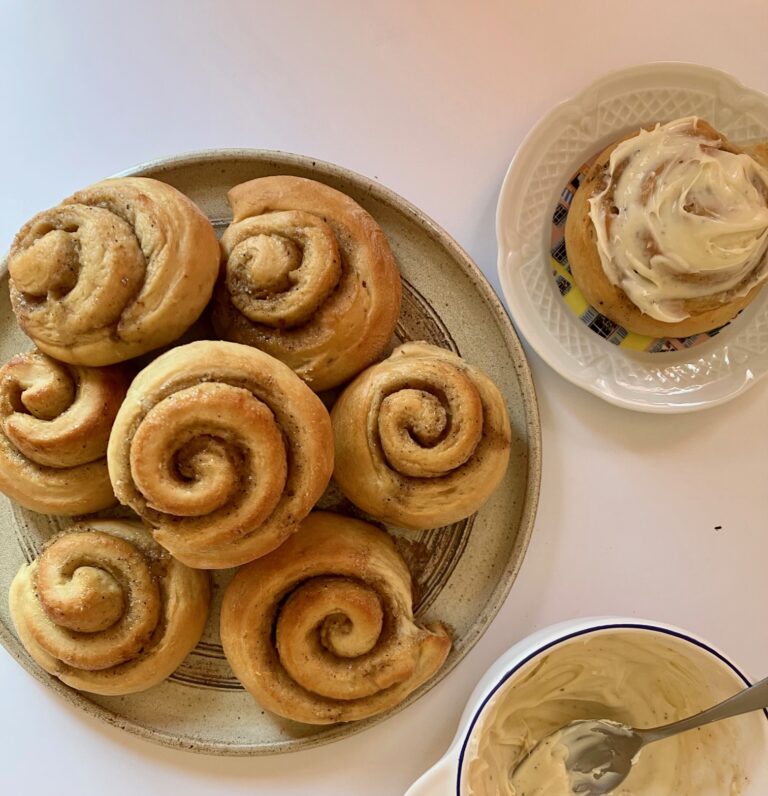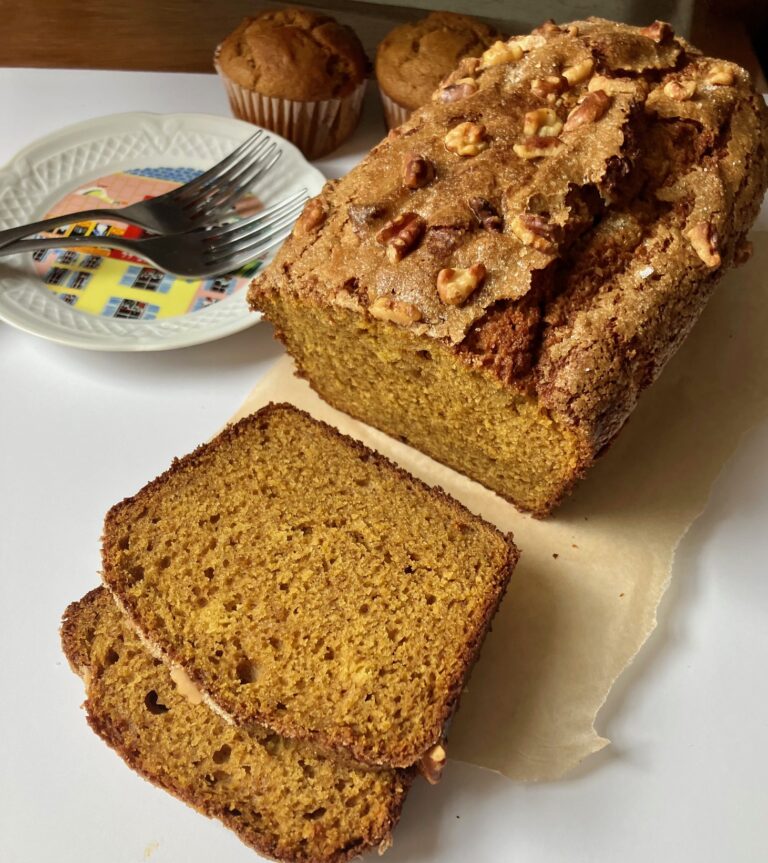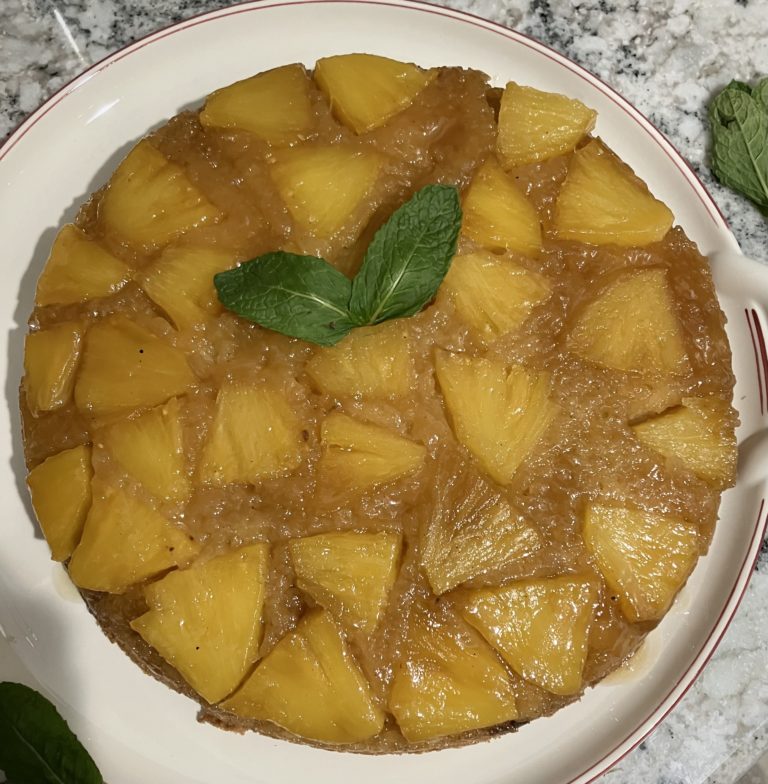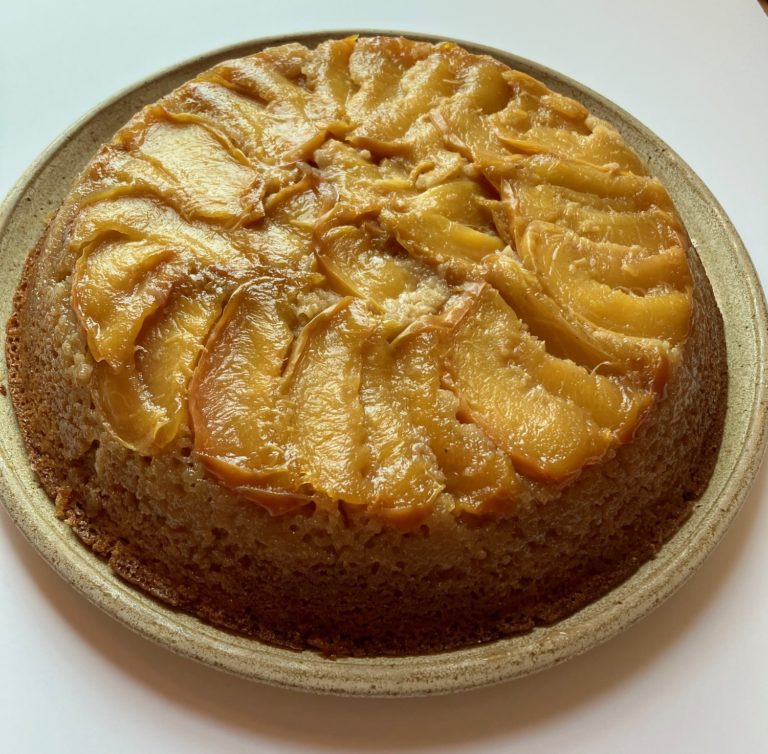This lemon layer cake is the perfect spring dessert–the flavors are bright and fresh and the cake is light and pillowy. It feels decadent and sophisticated and yet light and breezy at the same time. I have historically not been much of a cake person, but this cake has the perfect amount of airiness and sweetness (aka not too sweet) to transform me into a cake lover. Let’s break down this lemon thyme cake into its glorious components:
- Lemon thyme chiffon cake: This oil-based case is supremely moist and is flavored with lemon juice, lemon zest, and heaps of minced fresh thyme. Thyme is a very subtle flavor so two tablespoons are needed to really bring out the fragrance of the herb and complement the lemon. The cake uses whipped egg whites for light and airy volume and is baked in a single sheet pan and then cut out into three layers.
- Earl grey thyme syrup: A syrup is a great way to add even more moisture and flavor to the cake. In this cake, a simple syrup is infused with earl grey tea and a large handful of thyme. The bitterness of the tea counteracts some of the syrup’s sweetness and adds a robust flavor to the syrup, along with citrusy notes. This syrup is generously brushed over each cake layer.
- Lemon curd: The layer cake gets its sharp burst of flavor and brightness from my very lemony lemon curd. Both lemon juice and zest are used to flavor the curd, and butter provides an added silkiness to the texture. No flour, no cornstarch to dilute the lemon flavor–just egg yolks to thicken the curd.
- Earl grey buttercream: We have an earl grey-flavored swiss meringue buttercream to finish it off. Less sweet than an American buttercream, the swiss meringue buttercream is made by heating egg whites with sugar in a bowl over simmering water and then whipping the egg whites with butter to create a silky frosting. In this case, the butter is first infused with earl grey tea (and I’ve learned that you really have to use a lot of tea for this) to impart earl grey flavor into the buttercream. This helps mellow out the sweetness and add a delightful final layer of flavor to the cake.
While these components may seem overwhelming, each one is quite manageable, and the process can be split over three days or even more, since components can be made in advance and refrigerated for several days. On day 1, you can make the cake, syrup, and lemon curd. On day two, you can make the buttercream and assemble the layers. And on day three, you can frost the cake and decorate.
Lastly, I must credit the great Natasha Pickowicz, whose videos and articles have taught me the foundations of cake-baking. It is through her approach that I learned the importance of the cake soak, strategies for cutting out a cake from a sheet pan, etc. The chiffon cake base and the swiss meringue are both adapted from her citrus wedding cake recipe and several of the methods are borrowed from her general approach to cake-baking and assembly.
Lemon thyme cake with earl grey buttercream
Course: Cakes and custardsDifficulty: Weekend baking project1
8-inch layer cake4
hours18
minutesThis lemon thyme layer cake is bursting with bright, citrusy flavors set atop a backdrop of floral notes from earl grey and thyme. Tart and vibrant lemon curd and creamy earl grey buttercream are sandwiched between layers of fragrant and moist lemon-thyme cake soaked in a earl grey thyme syrup. While there are many elements to this cake, it is a serious crowd pleaser and each element alone comes together without much trouble.
Ingredients
- For the lemon chiffon cake
4 large eggs, separated
1/3 cup neutral oil (i.e. canola or vegetable oil)
1 tsp vanilla extract
1 1/3 cups (267g) granulated sugar
1 cup + 1 Tbsp (127g) cake flour
2 1/2 tsp baking powder
1/2 tsp kosher salt
zest of one lemon
2 Tbsp lemon juice
3 Tbsp water
2 Tbsp thyme removed from stem, minced
- For the lemon curd
2 egg yolks
1 whole egg
zest of one lemon (1 Tbsp)
1/4 cup + 2 Tbsp lemon juice
1/4 cup + 2 Tbsp (75g) sugar
pinch of salt
4 Tbsp unsalted butter
- For the earl grey thyme syrup
1/2 cup (100g) granulated sugar
1/2 cup water
10-15 sprigs of thyme
1 earl grey tea bag or 1 tsp of loose leaf tea
Earl grey buttercream
4 egg whites
1 cup (200g) granulated sugar
1/3 cup (50g) confectioners’ sugar
1 1/2 tsp vanilla extract
pinch of salt
3 sticks of butter, unsalted (340g)
3 Tbsp earl grey tea
Instructions
- Make the chiffon cake
- Preheat the oven to 350F. In a medium bowl add the egg yolks, water, oil, lemon juice, lemon zest, vanilla, and thyme. Add in one cup (200g) of the granulated sugar and whisk until the mixture is smooth. Then, in a large bowl, add the flour, baking powder, and salt and whisk until just combined. Make a well in the center, pour in the yolk mixture, and stir just until fully combined.
- Using a clean bowl of a stand mixer or large mixing bowl, beat the egg whites on medium-high speed until they have substantially increased in volume and the mixture has transformed from bubbly to an opaque white color (2-3 minutes). Then, gradually add in the remaining 1/3 cup (67g) of sugar while continuing to use the mixer on medium speed, until the mixture is glossy, and if you lift the beaters up, you form peaks that are stiff at the base and slightly floppy at the top.
- Scrape 1/3 of the meringue into the yolk and flour mixture and gently fold with a spatula. Then, add the remaining meringue and gently fold until fully incorporated. You should have a uniform-looking, fluffy/voluminous mixture. Line the bottom of your pan with parchment paper (cut to fit the size of the bottom, leaving the sides of the pan exposed to help the cake have something to climb up as it rises). Then pour the mixture into the pan. Use an offset spatula or the back of a spoon to gently guide the mixture all the way to the corners and sides of the pan and to smooth out the surface.
- Bake for about 15-18 minutes, or until the center springs back to the touch and the edges are a light golden color. Rotate the tray half-way through baking to promote even browning. Let cool completely. Keep the cake in the pan, cover the top securely with plastic wrap, and refrigerate overnight or until ready to assemble the cake.
- Make the lemon curd
- To a non-aluminum saucepan, add the egg yolks, whole egg, lemon zest, lemon juice, salt, sugar, and butter.
- Stir to combine. Cook over medium low heat, stirring constantly, until the curd turns into an opaque yellow. It should coat the back of the spoon and leave a clear trail when you run your finger through it on the spoon. Immediately remove from the heat and transfer to a Tupperware container or bowl. Let cool, cover, and refrigerate at least 2-3 hours or until ready to assemble the cake.
- Make the cake soak
- In a small saucepan, add the water, sugar, tea, and sprigs of thyme. Place over medium-high heat and stir to dissolve the sugar. Then bring to a boil, turn the heat down and simmer for about 8-10 minutes. Let the thyme and tea continue to steep until the mixture has cooled down to about room temperature. Then pour into a glass or a bowl, cover, and set aside at room temperature until ready to use.
- Make the buttercream
- For the buttercream, start by infusing the butter with tea. To do this, melt 3 sticks of butter in a pan on medium-low heat along with loose leaf tea. Let simmer lightly, while stirring constantly for about 5 minutes. Then turn off the heat and let steep another 5-10 minutes. Strain into a bowl, using the back of a spoon to press out any extra butter from the tea leaves. Let sit until the butter solidifies and comes back to room temperature (this could be anywhere from 30 minutes to 1-2 hours depending on the temperature of your kitchen).
- Once your butter is at room temperature, start making the buttercream. In a double boiler or large bowl set over a pan filled with 1-2 inches of water (just make sure the bottom of the bowl does not touch the water directly), add the egg whites and granulated sugar. Heat over low heat, whisking constantly until the mixture reaches 155F, about 10 minutes.
- Remove from the heat and pour into a mixing bowl or bowl of a stand mixer and beat on medium-high speed until the mixture has cooled slightly. The bowl should no longer be hot to the touch, but should be only slightly warm, about 5 minutes. Add the confectioners’ sugar and mix on low speed to combine. Then add in the vanilla and salt.
- If the meringue is at approximately room temperature, move on to the next step. If not, you can beat it a bit longer to cool it down. Then, measure out the infused butter (294g—-the equivalent of 21 tablespoons)—-it should be pretty much all of the butter you melted, since some will get trapped in the tea leaves, but in case you are slightly short, you can add in a little bit of plain softened butter. Add the butter, a little bit at a time, beating at medium-high speed until all of the butter is fully incorporated. Then keep beating until the buttercream is smooth and fluffy. The meringue may look like it’s breaking up—-if that’s the case, just keep beating and be patient until it comes back together.
- Assemble the cake
- Remove the sheet pan from the fridge and run a knife around the sides of the pan to loosen the cake. Then, turn it over onto your work surface. Using an 8-inch pan or 8-inch round as a guide, cut out your three layers of cake. Do this by placing your pan in the bottom right corner, cutting as close to the edge as possible and tracing around your pan. Repeat with the top left corner. Then, use the remaining two corners to cut out two semi-circles, again using your pan to trace the curves from the other corners. Arrange the two semi-circles on top of a complete cake layer which will serve as a guide to identify the correct shape and size of the layer. Then cut out the remaining scraps to fill the gaps between the two semi-circles. This patchwork layer will become the middle cake layer and it won’t be noticeable so have no fear and just enjoy the creative process of cutting out cake shapes.
- Once your cake layers are cut out, line the bottom and up the sides of your cake pan with plastic wrap. If you don’t have an 8-inch cake pan, you can use a cake ring on a plate or you can even use the inside of an 8-inch saucepan to build your layers. Add the first layer to the pan with the side that had been on the parchment paper facing up. Brush the earl grey thyme syrup onto the top of the cake until the entire surface has been lightly moistened by the syrup. Then, spread a very thin layer of buttercream over the top. Dollop half of your lemon curd all across the top of the cake layer. You can use an offset spatula or back of a spoon to spread it out a little bit, but it’s also fine if it’s in a bunch of little dollops.
- Place the patchwork cake layer on top, starting with the two semicircles and filling in the gaps with strips of cake scraps. Then again, brush with the syrup, add a thin layer of buttercream, and dollop the remaining lemon curd on top. Place the final layer on top, and brush with the syrup. Bring the plastic wrap down to cover the top of the cake, and refrigerate overnight or place in the freezer. (You can technically ice the cake soon after building it, but the cake is so fragile then that it produces a lot of crumbs and can be messy). Cover and refrigerate the remaining buttercream.
- Once the cake is fully chilled or frozen, ice it the day you’re ready to serve the cake or the day before. Remove the buttercream from the fridge and let sit at room temperature for 45 minutes to an hour. Then beat it with a hand or stand mixer again until it becomes light and fluffy, with a smooth texture.
- Invert your cake onto an 8-inch cardboard round and place on a plate or cake stand. You can place a little dollop of icing on the cardboard round if you want your cake to stay in place. Remove the plastic wrap. Place a couple of large dollops of buttercream on the top of the cake and use an offset spatula to smooth it out over the top. Once you’ve covered the top, you can press down lightly and rotate the cake to help smooth out the look if you’d like. Then, add additional frosting to the sides of the cake, dabbing little bits around the side and using your offset spatula to smooth it out and cover the whole cake. Once you have full coverage, you can turn your spatula vertically and rotate the cake, pressing lightly to smooth out the layer of frosting. As you smooth it out, if excess buttercream gathers where the top and sides meet, you can remove that with your spatula. Refrigerate for at least an hour before serving. Then decorate as you please! You can add fresh or candied lemon slices or lemon peel to the top, sprigs of fresh thyme, or add ground up earl grey tea leaves on top of or mixed into the frosting for a speckled look.
- The cake can be refrigerated for up to two days before serving.
Notes
- All components of the cake can be refrigerated for quite some time, so feel free to break this up into different days. The cake in the sheet tray can be refrigerated for up to one week, as can the lemon curd. The syrup will be stable and can be refrigerated for a couple of weeks as well.
- Several aspects of this recipe have been adapted from Natasha Pickowicz’s citrus wedding cake, including the base for the chiffon cake, the basic technique for swiss meringue, and the approach of cutting three layers of cake from a single sheet pan.









Leave a comment